Related Research Articles

The oilbird, locally known as the guácharo, is a bird species found in the northern areas of South America including the island of Trinidad. It is the only species in the genus Steatornis and the family Steatornithidae. Nesting in colonies in caves, oilbirds are nocturnal feeders on the fruits of the oil palm and tropical laurels. They are the only nocturnal flying fruit-eating birds in the world. They forage at night, with specially adapted eyesight. However they navigate by echolocation in the same way as bats, one of the few birds to do so. They produce a high-pitched clicking sound of around 2 kHz that is audible to humans.

Kartchner Caverns State Park is a state park of Arizona, United States, featuring a show cave with 2.4 miles (3.9 km) of passages. The park is located 9 miles (14 km) south of the town of Benson and west of the north-flowing San Pedro River. Long hidden from view, the caverns were discovered in 1974 by local cavers, assisted by a state biologist who helped in its preservation.

Swildon's Hole is an extensive cave in Priddy, Somerset. At 9,144 metres (30,000 ft) in length, it is the longest cave on the Mendip Hills. It has been found to be connected to Priddy Green Sink and forms part of the Priddy Caves Site of Special Scientific Interest (SSSI).
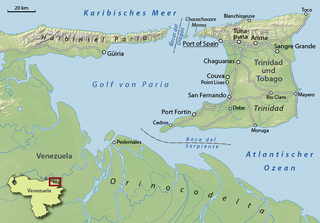
The Gulf of Paria is a 7,800 km2 (3,000 sq mi) shallow semi-enclosed inland sea located between the island of Trinidad and the east coast of Venezuela. It separates the two countries by as little as 15 km at its narrowest and 120 km at its widest points. The tides within the gulf are semi-diurnal in nature with a range of approximately 1m. The Gulf of Paria is considered to be one of the best natural harbours on the Atlantic coast of the Americas. The jurisdiction of the Gulf of Paria is split between Trinidad and Tobago and Venezuela with Trinidad and Tobago having control over approximately 2,940 km2 (1,140 sq mi)(37.7%) and Venezuela the remainder(62.3%).
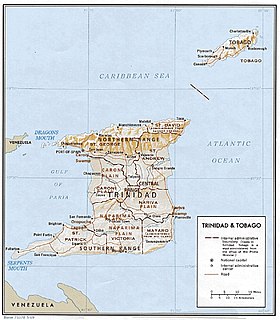
The Northern Range is the range of tall hills across north Trinidad, the major island in the Republic of Trinidad and Tobago. The hills range from the Chaguaramas peninsula on the west coast to Toco in the east. The Northern Range covers approximately twenty-five percent of the land area of Trinidad.

The short-tailed swift is a bird in the Apodidae, or swift family.

The Marble Arch Caves are a series of natural limestone caves located near the village of Florencecourt in County Fermanagh, Northern Ireland. The caves are named after the nearby Marble Arch, a natural limestone arch at the upstream end of Cladagh Glen under which the Cladagh River flows. The caves are formed from three rivers draining off the northern slopes of Cuilcagh mountain, which combine underground to form the Cladagh. On the surface, the river emerges from the largest karst resurgence in Ireland, and one of the largest in the United Kingdom. At 11.5 kilometres (7.1 mi) the Marble Arch Caves form the longest known cave system in Northern Ireland, and the karst is considered to be among the finest in the British Isles.

The Central Range is a mountain range on the island of Trinidad. It extends diagonally across the island and is a low-lying range with swampy areas rising to rolling hills. The tallest hills are Mount Tamana, Mount Harris and Brigand Hill, all located in the northeastern portion of the range. The Central Range mountains are biodiverse, and are home to the Tamana Caves. Trinidad's, as well as one of the world's largest bat colony is located here. Howler monkeys can be found here and numerous species of birds as well.

Reed's cave is a cave in Higher Kiln Quarry near Buckfastleigh, Dartmoor, Devon. It has many formations including the unique Little Man formation, which is beyond Easter Chamber. Devon's only true troglobite collembolan Pseudosinella dobati is recorded from this cave.

The ghost-faced bat is a bat in the genus Mormoops. It occurs in Belize, Colombia, Ecuador, El Salvador, Guatemala, Honduras, Mexico, Peru, Trinidad and Tobago, Venezuela, and Texas in the United States. Mormoops megalophylla is one of only two extant species within its genus, the other being the much smaller Mormoops blainvillii. These mammals are nocturnal and hunt using echolocation.
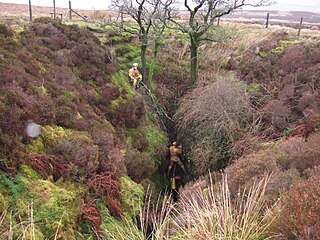
Rumbling Hole is a cave on Leck Fell, in Lancashire, England. Its entrance is a 50-metre (160 ft) deep fenced shaft, and it rapidly descends a series of pitches to a low aqueous passage that has been connected to Lost Johns' Cave. It is part of the Three Counties System, an 87-kilometre (54 mi) cave system that spans the borders of Cumbria, Lancashire, and North Yorkshire.
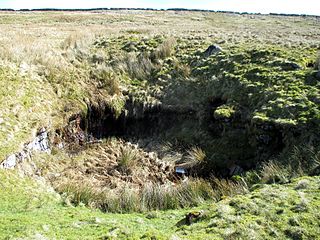
Langcliffe Pot is a cave system on the slopes of Great Whernside in Upper Wharfedale, about 3 kilometres (1.9 mi) SSE of Kettlewell in North Yorkshire. It is part of the Black Keld Site of Special Scientific Interest where the "underground drainage system which feeds the stream resurgence at Black Keld is one of the largest and deepest in Britain, although only a small proportion of its cave passages are accessible at present." Mossdale Caverns is also part of the Black Keld SSSI. Although a considerable length of passage has been explored in Langcliffe Pot, the current end is over 170 metres (560 ft) above the resurgence, and over 4 kilometres (2.5 mi) in distance. A trip to the far end has been described as "one of the most serious undertakings in British Caving".
The Caves of the Tullybrack and Belmore hills can be found in south-west County Fermanagh, Northern Ireland. The region is also described as the West Fermanagh Scarplands by environmental agencies and shares many similar karst features with the nearby Marble Arch Caves Global Geopark.

Eublaberus distanti, known as the six-spotted, four-spotted, four-spot, or Trinidad bat-cave roach or cockroach, is a primarily cave-dwelling Central and South American cockroach of the genus Eublaberus.
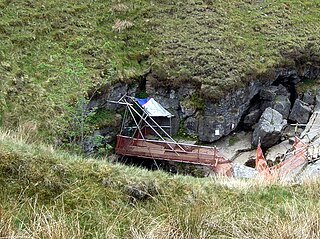
Jib Tunnel, also known as Lateral Passage is one of the entrances into the Gaping Gill cave system, located behind a large boulder in the north bank of Fell Beck adjacent to Gaping Gill Main Shaft. Although short, it leads to Lateral Shaft, a direct descent into Gaping Gill Main Chamber which is a popular caving route, and has had considerable significance in the history of the exploration of Gaping Gill. It lies within the designated Ingleborough Site of Special Scientific Interest.

Death's Head Hole is a cave on Leck Fell, in Lancashire, England. Its entrance is a 64-metre (210 ft) deep shaft. It leads into Lost Johns' Cave, and is part of the Three Counties System, an 87-kilometre (54 mi) cave system which spans the borders of Cumbria, Lancashire, and North Yorkshire.

Long Drop Cave is a cave on Leck Fell, in Lancashire, England. It leads into Death's Head Hole, and is part of the Three Counties System, an 87-kilometre (54 mi) cave system which spans the borders of Cumbria, Lancashire, and North Yorkshire.
Sir David Attenborough's myotis is a species of small bat in the family Vespertilionidae that is endemic to the Caribbean island of Tobago. Its presence on nearby Trinidad is as yet uncertain. It is the only mammal species currently known to be endemic to Trinidad and Tobago. It was named after famed English naturalist Sir David Attenborough.
The geology of Trinidad and Tobago includes two different islands with different geological histories.

Swinsto Cave is a limestone cave in West Kingsdale, North Yorkshire, England. It leads into Kingsdale Master Cave and it is popular with cavers as it is possible to descend by abseiling down the pitches, retrieving the rope each time, and exiting through Valley Entrance of Kingsdale Master Cave at the base of the hill. It is part of a 27-kilometre (17 mi) long cave system that drains both flanks of Kingsdale.
References
- 1 2 3 4 Kenny, Julian S. (1978–1979). "Floor plan, environment, and fauna of Tamana caves". Living World, Journal of the Trinidad and Tobago Field Naturalists' Club.
- ↑ Day, Michael J.; M. Sean Chenoweth (2004). "The karstlands of Trinidad and Tobago, their land use and conservation". The Geographical Journal. 170 (3): 256–266. doi:10.1111/j.0016-7398.2004.00124.x.
10°21′N61°11′W / 10.350°N 61.183°W
| This Trinidad and Tobago location article is a stub. You can help Wikipedia by expanding it. |